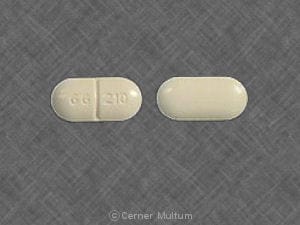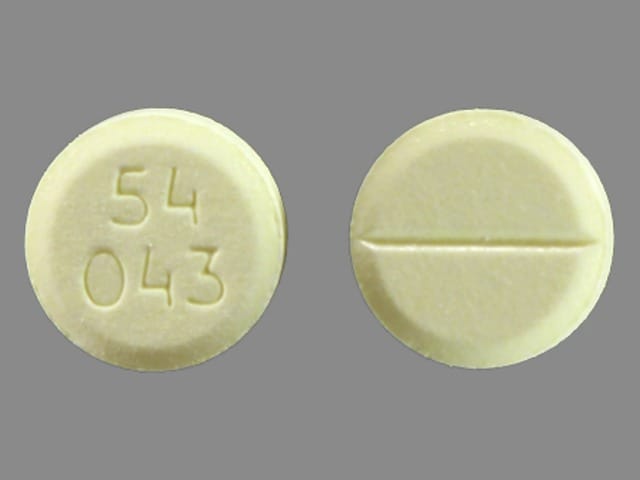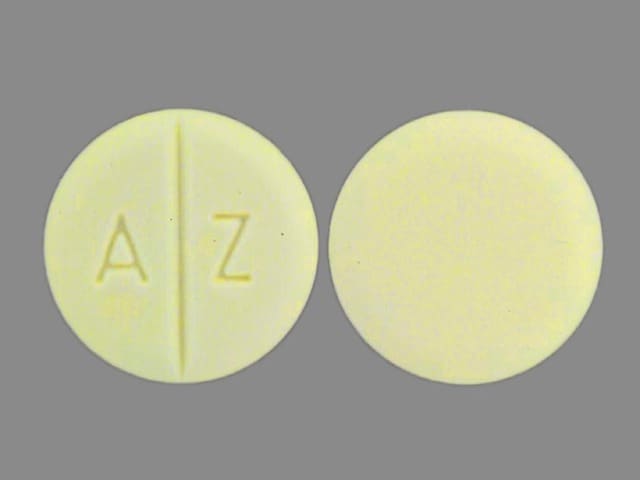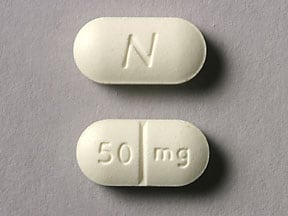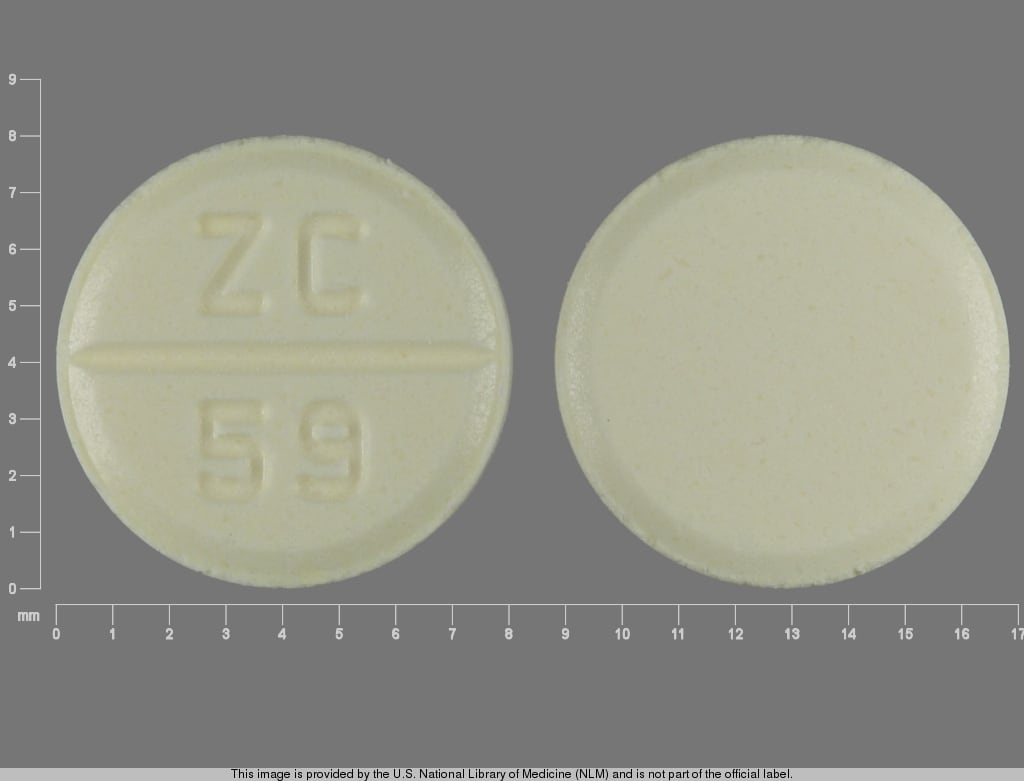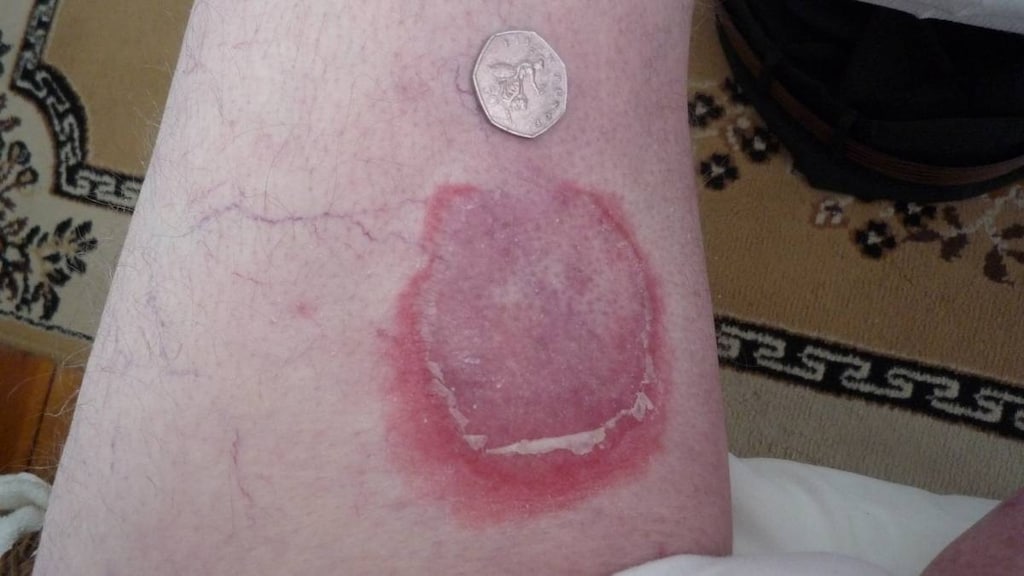Boxed Warning
Malignancy:
Chronic immunosuppression with azathioprine, a purine antimetabolite, increases risk of malignancy in humans. Reports of malignancy include post-transplant lymphoma and hepatosplenic T-cell lymphoma in patients with inflammatory bowel disease. Health care providers using this drug should be very familiar with this risk, as well as with the mutagenic potential to both men and women, and with possible hematologic toxicities. Inform patients of the risk of malignancy with azathioprine.
Dosage Forms
Excipient information presented when available (limited, particularly for generics); consult specific product labeling.
Solution Reconstituted, Injection [preservative free]:
Generic: 100 mg (1 ea)
Tablet, Oral:
Azasan: 75 mg, 100 mg [scored]
Imuran: 50 mg [scored]
Generic: 50 mg
Pharmacology
Mechanism of Action
Azathioprine is an imidazolyl derivative of mercaptopurine; metabolites are incorporated into replicating DNA and halt replication; also block the pathway for purine synthesis (Taylor 2005). The 6-thioguanine nucleotide metabolites appear to mediate the majority of azathioprine's immunosuppressive and toxic effects.
Pharmacokinetics/Pharmacodynamics
Absorption
Oral: Well absorbed
Metabolism
Hepatic; metabolized to 6-mercaptopurine via glutathione S-transferase (GST) reduction. Further metabolized (in the liver and GI tract) via major pathways: Hypoxanthine guanine phosphoribosyltransferase (to active metabolites: 6-thioguanine-nucleotides, or 6-TGNs), nucleotide diphosphate (NUDT15; converts 6-TGN to inactive 6-TG monophosphates), xanthine oxidase (to inactive metabolite: 6-thiouric acid), and thiopurine methyltransferase (TPMT) (to inactive metabolite: 6-methylmercaptopurine)
Excretion
Urine (primarily as metabolites)
Onset of Action
Immune thrombocytopenia (oral): Initial response: 30 to 90 days; Peak response: 30 to 120 days (Neunert 2011)
Time to Peak
Oral: 1 to 2 hours (including metabolites)
Half-Life Elimination
Azathioprine and mercaptopurine: Variable: ~2 hours (Taylor 2005)
Protein Binding
~30%
Use in Specific Populations
Special Populations: Renal Function Impairment
Clearance (azathioprine and metabolites) may be delayed in oliguric patients, particularly in those with tubular necrosis in the immediate post-transplant phase (deceased donor transplant).
Use: Labeled Indications
Kidney transplantation: Adjunctive therapy in prevention of rejection of kidney transplants
Guideline recommendations: While azathioprine is FDA approved for adjunctive therapy in prevention of rejection after kidney transplantation, it is no longer recommended as a first-line agent. The KDIGO clinical practice guidelines for care of kidney transplant recipients recommend a combination of maintenance immunosuppressive medications as maintenance therapy, including a calcineurin inhibitor and an antiproliferative agent (mycophenolate preferred) with or without corticosteroids. Azathioprine is recommended as a second-line antiproliferative agent for prevention of acute rejection (KDIGO [Kasiske 2010]).
Rheumatoid arthritis: Treatment of active rheumatoid arthritis (RA), to reduce signs and symptoms.
Appropriate use: While azathioprine is FDA approved for the treatment of active arthritis, the 2012 and 2015 guideline updates from the American College of Rheumatology for the treatment of rheumatoid arthritis do not include azathioprine due to infrequent use in rheumatoid arthritis and a lack of new data (ACR [Singh 2012]; ACR [Singh 2016]). However, azathioprine may be acceptable in certain situations where methotrexate is contraindicated and other alternatives are unable to be used (Cohen 2019).
Use: Off Label
Crohn disease (management after surgical resection)byes
Data from a small prospective, open-label pilot trial and from a meta-analysis support the use of azathioprine as management of Crohn disease after surgical resection and has demonstrated to lower endoscopic and clinical recurrence rates Armuzzi 2013, Peyrin-Biroulet 2009. Data from a randomized, placebo controlled trial suggests the benefit of azathioprine (after resection) may be increased when given in combination with metronidazole D’Haens 2008.
Based on the American Gastroenterological Association Institute Guidelines for the Management of Crohn Disease after Surgical Resection, azathioprine is an effective first-line agent for prophylactic therapy in patients who are at higher risk for clinical recurrence following surgical resection.
Crohn disease (remission maintenance or steroid-sparing therapy)byes
Data from two randomized double-blind, placebo-controlled trials support the use of azathioprine in combination with infliximab to achieve corticosteroid-free remission in the treatment of moderate to severe Crohn disease Colombel 2010, Lémann 2006.
Based on the American College of Gastroenterology guideline for the Management of Crohn disease in Adults, azathioprine in combination with an anti-TNF agent (eg, adalimumab, infliximab) for remission maintenance or reduction of steroid use is effective and recommended in the management of this condition. In addition, these guidelines state that azathioprine is not more effective than placebo to induce short-term symptomatic remission and is not recommended for this use. For moderate to severe or moderate to high risk disease, azathioprine may be used in treatment of active disease or as adjunctive therapy for reducing immunogenicity.
Dermatomyositis/polymyositis (relapsed or refractory) (adjunctive management)c
Clinical experience suggests that azathioprine may be of benefit (when added to prednisone) in the adjunctive management of relapsed or refractory dermatomyositis or polymyositis that has been unresponsive to conventional treatment, particularly in situations where methotrexate cannot be used as second-line therapy Briemberg 2003, Griger 2017.
Eosinophilic granulomatosis with polyangiitis (Churg-Strauss syndrome)b
Data from a multicenter, prospective, randomized, open label study, support the use of azathioprine as adjuvant immunosuppressive therapy for the treatment of eosinophilic granulomatosis with polyangiitis (Churg-Strauss syndrome) in patients (without poor prognosis factors) who were refractory to or had relapsed after remission induction with corticosteroids Ribi 2008.
Erythema multiforme (refractory)c
Data from a limited number of patients studied as well as clinical experience suggest that azathioprine may be of benefit in the management of erythema multiforme that is resistant to conventional treatment Farthing 1995, Schofield 1993, Schram 2011.
Hepatitis (autoimmune)yes
Based on the American Association for the Study of Liver Diseases (AASLD) guidelines for the diagnosis and management of autoimmune hepatitis, the use of azathioprine in combination with prednisone is an effective and recommended regimen in the management of this condition.
Immune thrombocytopenia, chroniccyes
Azathioprine in the management of refractory or relapsed chronic immune thrombocytopenia (ITP) has been primarily evaluated in noncontrolled settings and demonstrated benefit in up to two-thirds of treated patients
Lupus nephritis (maintenance phase)byes
Evidence-based guidelines suggest that azathioprine is effective as maintenance therapy in pregnant and nonpregnant patients with lupus nephritis. According to the guidelines, azathioprine and mycophenolate are considered equally effective as maintenance therapy in lupus nephritis. In patients who are pregnant or plan to become pregnant, azathioprine is the preferred therapy because mycophenolate is teratogenic ACR [Hahn 2012]. However, EULAR/ERA-EDTA guidelines recommend that if mycophenolate is successful in the induction phase of lupus nephritis treatment, it should be used over azathioprine as maintenance therapy EULAR/ERA-EDTA [Bertsias 2012].
Myasthenia graviscyes
Data in a limited number of clinical trials suggest that azathioprine may be beneficial for the treatment of myasthenia gravis when used in combination with glucocorticoids in patients who are not adequately controlled with pyridostigmine Myasthenia Gravis Study Group 1993, Palace 1998.
Based on the Myasthenia Gravis Foundation of American consensus-based guidance for the management of myasthenia gravis, azathioprine may be used as an immunosuppressive agent in patients with myasthenia gravis who have not met treatment goals after an adequate trial of pyridostigmine. Azathioprine may be added as monotherapy or in conjunction with glucocorticoids and/or pyridostigmine Palace 1998, Sanders 2016.
Pemphigus vulgarisb
Data from 2 small randomized studies support the use of azathioprine (in combination with prednisolone) for the treatment of newly diagnosed pemphigus vulgaris Chams-Davatchi 2007, Chams-Davatchi 2013.
Pericarditis, recurrentcyes
Evidence from noncontrolled trials indicates that azathioprine may be effective in preventing recurrences in patients with recurrent pericarditis refractory to conventional therapy. The European Society of Cardiology (ESC) guidelines on the diagnosis and management of pericardial diseases recommend that intravenous immunoglobulin, anakinra, or azathioprine be considered in cases of infection-negative, corticosteroid-dependent recurrent pericarditis in patients not responsive to colchicine.
Psoriasis (alternative agent)yes
According to the American Academy of Dermatology guidelines, methotrexate, cyclosporine, and acitretin are considered first-line systemic agents for the treatment of psoriasis, but azathioprine may be an appropriate alternative for certain patients AAD [Menter 2009].
Ulcerative colitis (remission induction)byes
Data from a randomized double-blind, placebo-controlled trial support the use of azathioprine, in combination with infliximab, to achieve corticosteroid-free remission in the remission induction treatment of moderate to severe ulcerative colitis Panaccione 2014. Clinical experience also suggests that azathioprine (in combination with infliximab) may be of benefit for remission induction in moderate to severe ulcerative colitis Danese 2011.
Based on the American College of Gastroenterology guidelines for Ulcerative Colitis in Adults, azathioprine may be used in combination with infliximab for induction of remission in patients with moderate to severely active ulcerative colitis when infliximab is used as induction therapy. According to the guidelines, azathioprine monotherapy is not recommended for remission induction in patients with moderately to severely active ulcerative colitis.
Ulcerative colitis (remission maintenance)cyes
In a meta-analysis of randomized clinical trials evaluating the efficacy of thiopurines (e.g. azathioprine) for induction and/or maintenance of ulcerative colitis clinical remission, evidence suggests azathioprine may be of benefit for the maintenance of remission in patients with ulcerative colitis Gisbert 2009.
Based on the American College of Gastroenterology guidelines for Ulcerative Colitis in Adults, azathioprine may be used for maintenance of remission in patients with previously moderately to severely active ulcerative colitis currently in remission following corticosteroid induction.
Uveitisc
Results from retrospective studies demonstrate that azathioprine is generally effective in treating uveitis Galor 2008, Pacheco 2008, Saadoun 2010, Pasadhika 2009. However, no controlled clinical trials have been performed. An expert review panel recommends azathioprine as third-line therapy for the treatment of uveitis in adults Díaz-Llopis 2009.
Additional Off-Label Uses
Adjunct in prevention of rejection of solid organ (non-kidney) transplants (other less toxic therapies may be preferred [eg, mycophenolate]).
Contraindications
Hypersensitivity to azathioprine or any component of the formulation; pregnancy (in patients with rheumatoid arthritis [see Pregnancy Considerations]); patients with rheumatoid arthritis and a history of treatment with alkylating agents (eg, cyclophosphamide, chlorambucil, melphalan) may have a prohibitive risk of malignancy with azathioprine treatment
Dosage and Administration
Dosing: Adult
Note: Consider testing for thiopurine S-methyltransferase (TPMT) and nudix hydrolase 15 (nucleotide diphosphatase; NUDT15) deficiency in patients who develop severe bone marrow toxicities (may require dose reduction or discontinuation). Dosage reduction or selection of alternative therapy is recommended in patients with TPMT and/or NUDT15 deficiency.
Crohn disease, management after surgical resection (off-label use): Oral:
Monotherapy: 2 to 2.5 mg/kg/day; begin within 2 to 4 weeks after surgery and continue for 12 to 24 months (Armuzzi 2013; Peyrin-Biroulet 2009).
Combination therapy (in combination with metronidazole): 100 mg daily (<60 kg) or 150 mg daily (≥60 kg) for up to 52 weeks (D'Haens 2008) or 2 mg/kg/day for ~18 months after surgery (De Cruz 2015). Note: The benefit of azathioprine may be increased when given in combination with a 3-month course of metronidazole (D'Haens 2008).
Crohn disease (remission maintenance or steroid-sparing therapy) (off-label use): Oral: 1.5 to 2.5 mg/kg/day in combination with an anti-TNF agent (eg, adalimumab, infliximab) (Colombel 2010; Lémann 2006; Lichtenstein 2018).
Dermatomyositis/polymyositis, adjunctive management (off-label use; based on limited data): Oral: 50 mg/day in conjunction with prednisone; increase by 50 mg/week to total dose of 2 to 3 mg/kg/day (Briemberg 2003); Note: Onset of beneficial effects may take 3 to 6 months; however, may be preferred over methotrexate in patients with pulmonary or hepatic toxicity.
Eosinophilic granulomatosis with polyangiitis (Churg-Strauss syndrome) (off-label use): Oral: 2 mg/kg/day for 6 months (Ribi 2008).
Erythema multiforme, refractory (off-label use; based on limited data): Oral: 100 to 150 mg/day (Farthing 1995; Schofield 1993; Schram 2011).
Hepatitis (autoimmune) (off-label use): IV, Oral: 1 mg/kg/day (usual dose: 50 mg once daily) in combination with corticosteroids; may increase to 2 mg/kg/day in patients who relapse or do not respond (AASLD [Manns 2010]; Lamers 2010). Most patients who are in complete remission for at least one year may continue azathioprine (without corticosteroids) at 2 mg/kg/day without relapse (Johnson 1995).
Immune thrombocytopenia, chronic (refractory or relapsed) (off-label use): Oral: 1 to 2 mg/kg/day; maximum dose: 150 mg/day (Provan 2010). Initial response is observed at 30 to 90 days; may take up to 6 months for peak response (Neunert 2011; Provan 2010).
Kidney transplantation: IV, Oral: Initial therapy following transplant: 3 to 5 mg/kg once daily (usually given as a single daily dose), then 1 to 3 mg/kg (usual dose: 50 to 150 mg/day) once daily maintenance or (off-label maintenance dosing, in combination with other maintenance immunosuppressant agents) Oral: 100 mg once daily (for patients <75 kg) or 150 mg (for patients ≥75 kg) once daily (Remuzzi 2007) or 2 mg/kg/day initially, with the dose adjusted based on safety/tolerability (Cristelli 2013). Note: The primary use of azathioprine in the setting of kidney transplantation has largely been replaced by the mycophenolic acid derivatives (Lee 2012). If other antiproliferative agents become intolerable, patients may be safely converted to a maintenance dose of azathioprine (El-Agroudy 2009; Lou 2004; Wuthrich 2000; Zhu 2008).
Pregnant patients: ≤2 mg/kg/day (Hou 2013).
Lupus nephritis, maintenance (off-label use): Oral: Initial: 2 mg/kg/day; may reduce to 1.5 mg/kg/day after 1 month (if proteinuria <1 g/day and serum creatinine stable) (Moroni 2006) or target dose: 2 mg/kg/day (Hahn 2012; Houssiau 2010).
Pregnant patients: ≤2 mg/kg/day (Hahn 2012).
Myasthenia gravis (off-label use): Patients who remain significantly symptomatic on pyridostigmine: Oral: Initial: 50 mg/day; increase by 50 mg increments every 1 to 2 weeks to a target dose of 2.5 to 3 mg/kg/day (Sanders 2016). May be added as monotherapy or in conjunction with glucocorticoids and/or pyridostigmine (Palace 1998; Sanders 2016). Onset of clinical response to azathioprine may take up to 1 year, with a maximum effect not apparent until 1 to 2 years (Saperstein 2004; Sieb 2014). Note: For patients who experience flu-like symptoms when initiating with 50 mg/day, some experts recommend initiating with 25 mg/day and gradually increasing the daily dose by 25 to 50 mg every 2 weeks up to 150 mg/day (Nicolle 2016).
Pemphigus vulgaris (off-label use): Oral: Initial: 2.5 mg/kg/day for 2 months, then reduce to 50 mg/day (in combination with prednisolone) (Chams-Davatchi 2007) or 2.5 mg/kg/day (in combination with prednisolone) (Chams-Davatchi 2013).
Pericarditis, recurrent (off-label use): Oral: 150 mg once daily for 2 to 3 months, then 100 mg once daily to suppress clinical symptoms (Marcolongo 1995).
Psoriasis, alternative agent (off-label use): Oral: Initial: 0.5 mg/kg/day, if no occurrence of cytopenia after 6 to 8 weeks of therapy, may increase by 0.5 mg/kg/day every 4 weeks until response; usual dosage: 75 to 150 mg/day; maximum doses may also be guided by TPMT activity (refer to guidelines for details) (AAD [Menter 2009]).
Rheumatoid arthritis (alternative agent):
Oral: 25 to 50 mg/day initially; after 2 weeks may increase by 50 mg/day (~0.5 mg/kg/day) every 4 weeks to 1.5 mg/kg/day; after 3 months if response is inadequate, a higher target dose of a maximum of 3 mg/kg/day may be needed (Belmont 2019).
Manufacturer’s labeling:
Initial: ~1 mg/kg/day (50 to 100 mg) given once daily or divided twice daily; after 6 to 8 weeks, may increase by 0.5 mg/kg every 4 weeks until response or up to 2.5 mg/kg/day; an adequate trial should be a minimum of 12 weeks.
Maintenance dose: Reduce dose by 0.5 mg/kg (~25 mg daily) every 4 weeks until lowest effective dose is reached; optimum duration of therapy not specified; may be discontinued abruptly (monitor for delayed toxicities).
Pregnant patients: ≤2 mg/kg/day (Flint 2016).
IV: Note: IV is indicated only in patients unable to tolerate oral medications (dosing should be transitioned from IV to oral as soon as tolerated):
Manufacturer’s labeling:
Initial: ~1 mg/kg/day (50 to 100 mg) given once daily or divided twice daily; after 6 to 8 weeks, may increase by 0.5 mg/kg every 4 weeks until response or up to 2.5 mg/kg/day; an adequate trial should be a minimum of 12 weeks.
Maintenance dose: Reduce dose by 0.5 mg/kg (~25 mg daily) every 4 weeks until lowest effective dose is reached; optimum duration of therapy not specified; may be discontinued abruptly (monitor for delayed toxicities).
Ulcerative colitis, remission induction (off-label use): Oral: 2.5 mg/kg/day in combination with infliximab (ACG [Rubin 2019]; Danese 2011; Panaccione 2014).
Ulcerative colitis, remission maintenance (off-label use): Oral: 2.5 mg/kg/day (Danese 2011; Gisbert 2009).
Uveitis (off-label use): Oral: 2 to 3 mg/kg/day given either alone or in conjunction with corticosteroids and/or immunosuppressants (Pacheco 2008).
Dosage adjustment for TPMT and/or NUDT15 deficiency:
Clinical Pharmacogenetics Implementation Consortium (CPIC) guidelines (Relling 2019):
Normal TPMT or NUDT15 activity (wild type): No initial dosage adjustment necessary; adjust dose based on condition being treated. Allow 2 weeks after each dosage adjustment to reach steady state.
TPMT intermediate or possible intermediate metabolizer or NUDT15 intermediate or possible intermediate metabolizer: Initiate azathioprine with the dose reduced to 30% to 80% of the usual dose and adjust based on the degree of myelosuppression and condition being treated. Allow 2 to 4 weeks after each dosage adjustment to reach steady state. If the starting dose is already below the normal recommended dose, dose reduction may not be recommended.
TPMT poor metabolizer: When used for nonmalignant conditions, consider alternative (non-thiopurine) immunosuppressant therapy. For malignancy, initiate azathioprine at a drastically reduced dose (reduce the daily dose by 10-fold and reduce the frequency from once daily to 3 times a week). Adjust dose based on the degree of myelosuppression and condition being treated. Allow 4 to 6 weeks after each dosage adjustment to reach steady state.
NUDT15 poor metabolizer: When used for nonmalignant conditions, consider alternative (non-thiopurine) immunosuppressant therapy. For malignancy, initiate azathioprine at a drastically reduced dose (reduce the daily dose by 10-fold). Adjust dose based on the degree of myelosuppression and condition being treated. Allow 4 to 6 weeks after each dosage adjustment to reach steady state.
Manufacturer’s labeling:
Heterozygous deficiency (intermediate activity): Reduced doses are recommended in patients with known heterozygous deficiency of TPMT or NUDT15. Patients who are heterozygous for both TPMT and NUDT15 may require more substantial dosage reduction.
Homozygous deficiency (low or deficient activity): Consider alternative therapies in patients with known homozygous deficiency of TPMT or NUDT15.
Dosage adjustment for concomitant use with allopurinol: Reduce azathioprine dose to one-third or one-fourth the usual dose when used concurrently with allopurinol. Patients with low or absent TPMT activity may require further dose reductions or discontinuation.
Dosing: Geriatric
Refer to adult dosing.
Dosing: Pediatric
Note: Patients with intermediate TPMT activity may be at risk for increased myelosuppression; those with low or absent TPMT activity receiving conventional azathioprine doses are at risk for developing severe, life-threatening myelotoxicity. Dosage reductions are recommended for patients with reduced TPMT activity. Intravenous (IV) dose is equivalent to oral dose (dosing should be transitioned from IV to oral as soon as tolerated).
Hepatitis, autoimmune: Limited data available: Children and Adolescents: Oral: Initial: 0.5 mg/kg/dose once daily; titrate as needed up to 2 mg/kg/dose once daily; for long-term therapy, a low-dose of 1 to 1.5 mg/kg/day may be effective in some patients (Della Corte, 2012; Vitfell-Pedersen, 2012)
Inflammatory bowel disease: Limited data available: Infants, Children, and Adolescents: Oral: 2 to 2.5 mg/kg/dose once daily; titrate to effect; usual reported range: 1 to 3 mg/kg/dose once daily; reported maximum daily dose: 4 mg/kg/day or 200 mg/day; may takes several weeks of therapy to be fully effective (Fuentes, 2003; Punati, 2011; Riello, 2011; Sandhu, 2010). Some data suggest that pediatric patients ≤6 years may require higher doses to achieve remission; a median dose of 3.51 mg/kg/day (maximum daily dose: 5 mg/kg/day) was reported to induce remission in 62% of patients ≤6 years of age vs 17% of those receiving lower doses (ie, <2 to 3 mg/kg/day study group; median dose: 2.46 mg/kg/day) (Grossman, 2008).
Immune thrombocytopenia (ITP), chronic refractory: Limited data available: Children ≥2 years and Adolescents: Oral: Maintenance: 2 to 2.5 mg/kg/day, rounded to the nearest 50 mg (Boruchov, 2007)
Juvenile-idiopathic arthritis (rheumatoid arthritis): Limited data available: Children and Adolescents: Oral: 2 to 2.5 mg/kg/dose once daily; data limited to single double-blind, placebo-controlled trial of pediatric patients (n=17 treatment group); efficacy results were not statistically significant (response rate: Treatment: 41% vs placebo: 27%); data suggested a minimum trial of 12 weeks to fully assess therapeutic response (AHRQ, 2011; Hashkes, 2005; Kvien, 1986)
Lupus nephritis, mild: Limited data available: Children and Adolescents: Oral: 2 to 2.5 mg/kg/dose once daily (Bertsias, 2012; Marks, 2010); Note: Some data suggest less effective in non-Caucasian pediatric patients; some centers recommend use for primary induction in Caucasian patients with less severe disease (Adams, 2006; Marks, 2010).
Myasthenia gravis, juvenile: Limited data available: Children and Adolescents: Oral: 1 to 3 mg/kg/dose once daily (Ashraf, 2006; Lindner, 1997)
Transplantation, solid organ: Limited data available: Infants, Children, and Adolescents: Oral: Initial: 3 to 5 mg/kg/dose once daily, beginning at the time of transplant; maintenance: 1 to 3 mg/kg/dose once daily (Denfield, 2010; Ford, 2006)
Uveitis, JIA-associated: Limited data available: Children and Adolescents: Oral: Initial mean dose: 2.4 mg/kg/dose once daily; reported range: 1.4 to 3.2 mg/kg/dose once daily; in a retrospective review of 41 children, a mean maintenance 2.1 mg/kg/dose (range: 1 to 2.8 mg/kg/dose) once daily was reported as monotherapy and/or in combination with other immunosuppressive agents; infectious etiology was excluded; the authors recommend doses of <3 mg/kg/day (Goebel, 2011)
Dosage adjustment for concomitant use with allopurinol: In pediatric patients, limited data is available; in adult patients, the following has been suggested: Reduce azathioprine dose to one-third or one-fourth the usual dose when used concurrently with allopurinol. Patients with low or absent TPMT activity may require further dose reductions or discontinuation.
Dosage adjustment for toxicity: In pediatric patients, limited data is available, in adult patients the following has been suggested:
Rapid WBC count decrease, persistently low WBC count, or serious infection: Reduce dose or temporarily withhold treatment.
Severe toxicity in renal transplantation: May require discontinuation.
Hepatic sinusoidal obstruction syndrome (SOS; veno-occlusive disease): Permanently discontinue.
Dosing: Adjustment for Toxicity
Rapid WBC count decrease, persistently low WBC count, or serious infection: Reduce dose or temporarily withhold treatment.
Severe toxicity (hematologic or other) in kidney transplantation: May require discontinuation.
Hepatic sinusoidal obstruction syndrome (SOS; veno-occlusive disease): Permanently discontinue.
Rheumatoid arthritis: Leukopenia and thrombocytopenia: Consider a 50% dose reduction or discontinuation; permanently discontinue for persistent cytopenias (Belmont 2019).
Reconstitution
Injection: Add 10 mL of sterile water for injection, and swirl until solution is clear. May further dilute into NS or dextrose for infusion.
Canadian product: Reconstitute with 5 to 10 mL sterile water for injection (adding 5 mL will result in a 10 mg/mL solution). May further dilute in NS for infusion.
Extemporaneously Prepared
A 50 mg/mL oral suspension may be prepared with tablets. Crush one-hundred-twenty 50 mg tablets in a mortar and reduce to a fine powder. Add 40 mL of either cherry syrup (diluted 1:4 with Simple Syrup, USP); a 1:1 mixture of Ora-Sweet and Ora-Plus; or a 1:1 mixture of Ora-Sweet SF and Ora-Plus, and mix to a uniform paste. Mix while adding the vehicle in incremental proportions to almost 120 mL; transfer to a calibrated bottle, rinse mortar with vehicle, and add quantity of vehicle sufficient to make 120 mL. Label "shake well", "refrigerate", and "protect from light". Stable for 60 days refrigerated.
Allen LV Jr and Erickson MA 3rd, "Stability of Acetazolamide, Allopurinol, Azathioprine, Clonazepam, and Flucytosine in Extemporaneously Compounded Oral Liquids," Am J Health Syst Pharm, 1996, 53(16):1944-9.8862208
Administration
Oral: Most commonly administered once daily. Administering tablets after meals or in divided doses may decrease adverse GI events.
IV: Infusion is usually administered over 30 to 60 minutes. Infusion time is dependent upon the final volume after dilution. While normally given over 30 to 60 minutes, it may be infused over 5 minutes up to over 8 hours.
Storage
Injection: Store at 20°C to 25°C (68°F to 77°F). Protect from light. Reconstituted solution should be used within 24 hours.
Tablet: Store at 20°C to 25°C (68°F to 77°F). Protect from light and moisture.
AzaTHIOprine Images
Drug Interactions
5-Aminosalicylic Acid Derivatives: May decrease the metabolism of Thiopurine Analogs. Monitor therapy
Allopurinol: May increase serum concentrations of the active metabolite(s) of AzaTHIOprine. More specifically, allopurinol may increase mercaptopurine serum concentrations and promote formation of active thioguanine nucleotides. Management: Reduce the azathioprine dose to one third to one quarter of the usual dose if used concomitantly with allopurinol, and monitor closely for systemic toxicity (particularly hematologic toxicity, nausea, and vomiting). Consider therapy modification
Angiotensin-Converting Enzyme Inhibitors: May enhance the myelosuppressive effect of AzaTHIOprine. Monitor therapy
Anti-TNF Agents: May enhance the adverse/toxic effect of Thiopurine Analogs. Specifically, the risk for T-cell non-Hodgkin's lymphoma (including hepatosplenic T-cell lymphoma) may be increased. Exceptions: Lenalidomide; Pomalidomide; Thalidomide. Monitor therapy
Baricitinib: Immunosuppressants may enhance the immunosuppressive effect of Baricitinib. Management: Use of baricitinib in combination with potent immunosuppressants such as azathioprine or cyclosporine is not recommended. Concurrent use with antirheumatic doses of methotrexate or nonbiologic disease modifying antirheumatic drugs (DMARDs) is permitted. Consider therapy modification
BCG (Intravesical): Immunosuppressants may diminish the therapeutic effect of BCG (Intravesical). Avoid combination
Cladribine: May enhance the immunosuppressive effect of Immunosuppressants. Avoid combination
Coccidioides immitis Skin Test: Immunosuppressants may diminish the diagnostic effect of Coccidioides immitis Skin Test. Monitor therapy
Cyclophosphamide: AzaTHIOprine may enhance the hepatotoxic effect of Cyclophosphamide. Monitor therapy
Denosumab: May enhance the adverse/toxic effect of Immunosuppressants. Specifically, the risk for serious infections may be increased. Monitor therapy
Echinacea: May diminish the therapeutic effect of Immunosuppressants. Consider therapy modification
Febuxostat: May increase the serum concentration of AzaTHIOprine. Avoid combination
Fingolimod: Immunosuppressants may enhance the immunosuppressive effect of Fingolimod. Management: Avoid the concomitant use of fingolimod and other immunosuppressants when possible. If combined, monitor patients closely for additive immunosuppressant effects (eg, infections). Consider therapy modification
InFLIXimab: May enhance the adverse/toxic effect of AzaTHIOprine. Specifically, the risk for T-cell non-Hodgkin's lymphoma (including hepatosplenic T-cell lymphoma) may be increased. InFLIXimab may increase serum concentrations of the active metabolite(s) of AzaTHIOprine. Monitor therapy
Leflunomide: Immunosuppressants may enhance the adverse/toxic effect of Leflunomide. Specifically, the risk for hematologic toxicity such as pancytopenia, agranulocytosis, and/or thrombocytopenia may be increased. Management: Consider not using a leflunomide loading dose in patients receiving other immunosuppressants. Patients receiving both leflunomide and another immunosuppressant should be monitored for bone marrow suppression at least monthly. Consider therapy modification
Mercaptopurine: AzaTHIOprine may enhance the myelosuppressive effect of Mercaptopurine. Avoid combination
Natalizumab: Immunosuppressants may enhance the adverse/toxic effect of Natalizumab. Specifically, the risk of concurrent infection may be increased. Avoid combination
Nivolumab: Immunosuppressants may diminish the therapeutic effect of Nivolumab. Consider therapy modification
Ocrelizumab: May enhance the immunosuppressive effect of Immunosuppressants. Monitor therapy
Pidotimod: Immunosuppressants may diminish the therapeutic effect of Pidotimod. Monitor therapy
Pimecrolimus: May enhance the adverse/toxic effect of Immunosuppressants. Avoid combination
Ribavirin (Oral Inhalation): May increase serum concentrations of the active metabolite(s) of AzaTHIOprine. Specifically, concentrations of potentially myelotoxic methylated metabolites may be increased, while concentrations of active 6-thioguanine nucleotides may be decreased. Management: Consider using alternative agent(s) when possible. When these drugs are used in combination, monitor patients extra closely for signs/symptoms of myelosuppression. Consider therapy modification
Ribavirin (Systemic): May increase serum concentrations of the active metabolite(s) of AzaTHIOprine. Specifically, concentrations of potentially myelotoxic methylated metabolites may be increased, while concentrations of active 6-thioguanine nucleotides may be decreased. Management: Consider using alternative agent(s) when possible. When these drugs are used in combination, monitor patients closely for signs/symptoms of myelosuppression. Consider therapy modification
Roflumilast: May enhance the immunosuppressive effect of Immunosuppressants. Consider therapy modification
Siponimod: Immunosuppressants may enhance the immunosuppressive effect of Siponimod. Monitor therapy
Sipuleucel-T: Immunosuppressants may diminish the therapeutic effect of Sipuleucel-T. Management: Evaluate patients to see if it is medically appropriate to reduce or discontinue therapy with immunosuppressants prior to initiating sipuleucel-T therapy. Consider therapy modification
Sulfamethoxazole: May enhance the myelosuppressive effect of AzaTHIOprine. Monitor therapy
Tacrolimus (Topical): May enhance the adverse/toxic effect of Immunosuppressants. Avoid combination
Tertomotide: Immunosuppressants may diminish the therapeutic effect of Tertomotide. Monitor therapy
Tofacitinib: Immunosuppressants may enhance the immunosuppressive effect of Tofacitinib. Management: Concurrent use with antirheumatic doses of methotrexate or nonbiologic disease modifying antirheumatic drugs (DMARDs) is permitted, and this warning seems particularly focused on more potent immunosuppressants. Consider therapy modification
Trastuzumab: May enhance the neutropenic effect of Immunosuppressants. Monitor therapy
Trimethoprim: May enhance the myelosuppressive effect of AzaTHIOprine. Monitor therapy
Upadacitinib: Immunosuppressants may enhance the immunosuppressive effect of Upadacitinib. Avoid combination
Vaccines (Inactivated): Immunosuppressants may diminish the therapeutic effect of Vaccines (Inactivated). Management: Vaccine efficacy may be reduced. Complete all age-appropriate vaccinations at least 2 weeks prior to starting an immunosuppressant. If vaccinated during immunosuppressant therapy, revaccinate at least 3 months after immunosuppressant discontinuation. Consider therapy modification
Vaccines (Live): AzaTHIOprine may enhance the adverse/toxic effect of Vaccines (Live). AzaTHIOprine may diminish the therapeutic effect of Vaccines (Live). Management: Low-dose azathioprine (3 mg/kg/day or less) is not considered sufficiently immunosuppressive to create vaccine safety concerns and is not a contraindication for administration of zoster vaccine. Higher doses of azathioprine should be avoided. Consider therapy modification
Vitamin K Antagonists (eg, warfarin): AzaTHIOprine may diminish the anticoagulant effect of Vitamin K Antagonists. Monitor therapy
Test Interactions
TPMT phenotyping results may not be accurate following recent blood transfusions.
Adverse Reactions
Frequency not always defined; dependent upon dose, duration, indication, and concomitant therapy.
Central nervous system: Malaise
Gastrointestinal: Nausea and vomiting (rheumatoid arthritis: 12%), diarrhea
Hematologic & oncologic: Leukopenia (renal transplant: >50%; rheumatoid arthritis: 28%), neoplasia (renal transplant 3% [other than lymphoma], 0.5% [lymphoma]), thrombocytopenia
Hepatic: Hepatotoxicity, increased serum alkaline phosphatase, increased serum bilirubin, increased serum transaminases
Infection: Increased susceptibility to infection (renal transplant 20%; rheumatoid arthritis <1%; includes bacterial, fungal, protozoal, viral, opportunistic, and reactivation of latent infections)
Neuromuscular & skeletal: Myalgia
Miscellaneous: Fever
<1%, postmarketing and/or case reports: Abdominal pain, acute myelocytic leukemia, alopecia, anemia, arthralgia, bone marrow depression, hemorrhage, hepatic sinusoidal obstruction syndrome (formerly known as hepatic veno-occlusive disease), hepatosplenic T-cell lymphomas, hepatotoxicity (idiosyncratic) (Chalasani, 2014), hypersensitivity, hypotension, interstitial pneumonitis (reversible), JC virus infection, macrocytic anemia, malignant lymphoma, malignant neoplasm of skin, negative nitrogen balance, pancreatitis, pancytopenia, progressive multifocal leukoencephalopathy, skin rash, steatorrhea, Sweet's syndrome (acute febrile neutrophilic dermatosis)
Warnings/Precautions
Concerns related to adverse effects:
- GI toxicity: The frequency of GI adverse effects (nausea and vomiting) may be decreased with dividing dose or administering after meals. GI hypersensitivity with severe nausea and vomiting has been reported; diarrhea, rash, fever, malaise, myalgia, hypotension, and liver enzyme abnormalities may also occur. Symptoms usually develop within the first several weeks of treatment and are generally reversible upon discontinuation; may recur upon rechallenge.
- Hematologic toxicity: Dose-related hematologic toxicities (leukopenia, thrombocytopenia, and anemias, including macrocytic anemia and/or pancytopenia) may occur; may be severe and/or delayed. Thiopurine methyltransferase (TPMT) genotyping or phenotyping and nudix hydrolase 15 (nucleotide diphosphate [NUDT15]) genotyping may help to identify patients who are at an increased risk for developing azathioprine toxicity (see "TPMT or NUDT 15 deficiency" below). Myelosuppression may be more severe with kidney transplants undergoing rejection. Monitor CBC with differential and platelets weekly during the first month, then twice a month for 2 months, then monthly (or more frequently if clinically indicated). May require treatment interruption, dose reduction, or selection of alternate therapy. Leukopenia does not correlate with therapeutic effect and the dose should not be increased intentionally to lower the white blood cell count.
- Hepatotoxicity: Hepatotoxicity (transaminase, bilirubin, and/or alkaline phosphatase elevations) may occur, usually in kidney transplant patients. Usually occurs within 6 months of transplant and is normally reversible with discontinuation. Monitor liver function periodically. Rarely, hepatic sinusoidal obstruction syndrome (SOS; formerly called veno-occlusive disease [VOD]) has been reported; discontinue if hepatic SOS is suspected.
- Infections: Chronic immunosuppression increases the risk of serious, sometimes fatal, infections (bacterial, viral, fungal, protozoal, and opportunistic), including reactivation of latent infections.
- Malignancy: [US Boxed Warning]: Chronic immunosuppression with azathioprine (a purine antimetabolite), increases the risk of malignancy. Malignancies reported have included post-transplant lymphoma and hepatosplenic T-cell lymphoma (HSTCL) in patients with inflammatory bowel disease. Health care providers using this medication should be very familiar with this risk, as well as with the mutagenic potential to both men and women, and with possible hematologic toxicities. Patients should be informed of the risk for malignancy development. HSTCL is a rare white blood cell cancer that is usually fatal and has predominantly occurred in adolescents and young adults treated for Crohn disease or ulcerative colitis and receiving tumor necrosis factor blockers (eg, adalimumab, certolizumab pegol, etanercept, golimumab), azathioprine, and/or mercaptopurine. Most cases of HSTCL have occurred in patients treated with a combination of immunosuppressant agents, although there have been reports of HSTCL in patients receiving azathioprine or mercaptopurine monotherapy. Kidney transplant patients are known to be at increased risk for malignancy (eg, skin cancer, lymphoma), the risk is increased with aggressive immunosuppression. Limit sun and ultraviolet light exposure and use appropriate sun protection.
- Progressive multifocal leukoencephalopathy: Cases of JC virus-associated infection resulting in progressive multifocal leukoencephalopathy (PML), have been reported in patients treated with immunosuppressants, including azathioprine (some cases have been fatal). Risk factors for PML include treatment with immunosuppressants and immune system impairment. Consider a diagnosis of PML in any patient presenting with new-onset neurological manifestations; consultation with a neurologist as clinically indicated may be warranted. Consider decreasing the degree of immunosuppression with respect to the risk of organ rejection in transplant patients.
Disease-related concerns:
- Hepatic impairment: Use with caution in patients with hepatic impairment.
- Renal impairment: Use with caution in patients with renal impairment; dosage reductions may be necessary.
- TPMT or NUDT15 deficiency: Patients with TPMT or NUDT15 deficiency may be at an increased risk of severe and life-threatening myelotoxicity with conventional azathioprine doses. Death associated with pancytopenia has been reported in patients with absent TPMT activity receiving azathioprine. Individuals who are TPMT homozygous or compound heterozygous deficient are at very high risk for severe myelosuppression (Relling 2019). TPMT genotyping or phenotyping and NUDT15 genotyping may assist in identifying patients at risk for developing toxicity. Consider testing for TPMT and NUDT15 deficiency in patients with severe myelosuppression. However, TPMT and NUDT15 testing cannot substitute for monitoring CBC in patients receiving azathioprine. Accurate phenotyping (red blood cell TPMT activity) results are not possible in patients who have received recent blood transfusions. The Clinical Pharmacogenetics Implementation Consortium (CPIC) guideline for thiopurine dosing based on TPMT and NUDT15 genotypes (Relling 2019) recommend reduced initial doses for TPMT and NUDT15 intermediate (and possible intermediate) metabolizers (with dosage adjustments based on myelosuppression). For TPMT and NUDT15 poor metabolizers, CPIC guidelines recommend considering alternative non-thiopurine agents for nonmalignant conditions and drastically reduced doses if used to treat malignancy. Genetic TPMT deficiency is the primary cause of thiopurine intolerance in Europeans and Africans; NUDT15 risk alleles are associated with a majority of thiopurine intolerance in Asians and are also common in Hispanics (Relling 2019).
Concurrent drug therapy issues:
- Drug-drug interactions: Potentially significant interactions may exist, requiring dose or frequency adjustment, additional monitoring, and/or selection of alternative therapy. Consult drug interactions database for more detailed information.
- Mercaptopurine: Azathioprine is metabolized to mercaptopurine; concomitant use may result in profound myelosuppression and should be avoided.
- Vaccines: Immune response to vaccines may be diminished. Toxicity or adverse reactions to live vaccines may be enhanced (depending on the azathioprine dose).
Other warnings/precautions:
- Discontinuation of therapy: Myasthenia gravis: Abrupt cessation of this or any immunosuppressant, especially in clinically unstable individuals, may result in rapid deterioration of myasthenic symptoms and possibly myasthenic crisis (Melzer 2016).
- Experienced health care provider: [US Boxed Warning]: Should be prescribed by health care providers familiar with the risks, including hematologic toxicities and mutagenic potential.
Monitoring Parameters
CBC with differential and platelets (weekly during first month, twice monthly for months 2 and 3, then monthly thereafter; monitor more frequently with dosage modifications), total bilirubin, liver function tests (every 3 months), CrCl, monitor for signs/symptoms of infection and malignancy (eg, splenomegaly, hepatomegaly, abdominal pain, persistent fever, night sweats, weight loss). Azathioprine has been associated with skin cancer with long-term use after kidney transplantation. Patients taking azathioprine for a prolonged time period should avoid sun exposure and be monitored for skin cancer regularly.
Rheumatoid arthritis: CBC with differential at baseline and every 1 to 2 weeks with dose changes, the every 1 to 3 months thereafter, serum creatinine at baseline, and liver function tests at baseline (American College of Rheumatology [ACR 2002]). After a stable dose is achieved, consider monitoring CBC every 4 to 6 weeks and liver function tests every 6 to 8 weeks during azathioprine treatment (Belmont 2019).
Thiopurine S-methyltransferase (TPMT) genotyping or phenotyping: Consider testing for TPMT deficiency, particularly in patients with abnormally low CBC unresponsive to dose reduction. TPMT genotyping or phenotyping may assist in identifying patients at risk for developing toxicity (Relling 2019).
Nudix hydrolase 15 (NUDT15) genotyping: Consider genotyping for NUDT15 deficiency in patients who experience severe bone marrow toxicities or repeated myelosuppressive episodes. NUDT15 genotyping may assist in identifying patients at risk for developing toxicity (Relling 2019).
The American Gastroenterological Association suggests routine TPMT testing (enzymatic or genotype) to guide thiopurine dosing in adult patients initiated on thiopurines. The AGA further suggests reactive thiopurine metabolite monitoring to guide therapy changes in adult patients treated with active inflammatory bowel disease or patients experiencing adverse effects potentially due to thiopurine toxicity (targeted 6-thioguanine level between 230 to 450 pmol/8 x 108 RBCs) (Feuerstein 2017).
Pregnancy
Pregnancy Risk Factor
D
Pregnancy Considerations
Azathioprine crosses the placenta.
Product labeling notes congenital anomalies, immunosuppression, hematologic toxicities (lymphopenia, pancytopenia), and intrauterine growth retardation from case reports following use in maternal kidney allograft recipients (based on additional data, this may, in part, be dose related [Colla 2018]). Intrauterine growth retardation and preterm delivery are also reported in pregnancies following a kidney transplant. In addition, fetal immunosuppression and hematologic toxicities are decreased when maintaining appropriate maternal leukocyte counts. Stable immunosuppression is required in pregnant females who have had a kidney transplant; an increased risk of fetal malformations has not been observed with azathioprine. Azathioprine therapy is considered acceptable in pregnant patients with kidney transplants; lower doses (<2 mg/kg/day) are recommended (Colla 2018; Durst 2015; Gonzalez Suarez 2019; Hou 2013; KDIGO 2009).
Available guidelines suggest that use of azathioprine is acceptable for the treatment of rheumatoid arthritis in pregnant females (Flint 2016), although use for this indication is contraindicated by the manufacturer. Azathioprine may also be used for the adjunctive treatment of lupus nephritis in pregnant females (Hahn 2012). Females with Crohn disease or ulcerative colitis who are on maintenance therapy with azathioprine may continue treatment during pregnancy (Nguyen 2016). Agents other than azathioprine are recommended for the treatment of immune thrombocytopenia in pregnant females (Neunert 2011).
The manufacturer recommends that females of reproductive potential should avoid becoming pregnant during treatment. Azathioprine is compatible for use in males with female partners of reproductive potential (Flint 2016).
The Transplant Pregnancy Registry International (TPR) is a registry that follows pregnancies that occur in maternal transplant recipients or those fathered by male transplant recipients. The TPR encourages reporting of pregnancies following solid organ transplant by contacting them at 1-877-955-6877 or https://www.transplantpregnancyregistry.org.
Patient Education
What is this drug used for?
- It is used after a kidney transplant to keep the body from rejecting the kidney.
- It is used to treat rheumatoid arthritis.
- It may be given to you for other reasons. Talk with the doctor.
Frequently reported side effects of this drug
- Nausea
- Vomiting
Other side effects of this drug: Talk with your doctor right away if you have any of these signs of:
- Infection
- Liver problems like dark urine, fatigue, lack of appetite, nausea, abdominal pain, light-colored stools, vomiting, or yellow skin or eyes
- Severe loss of strength and energy
- Bruising
- Bleeding
- Severe dizziness
- Passing out
- Diarrhea
- Muscle pain
- Muscle weakness
- Swollen glands
- Night sweats
- Shortness of breath
- Excessive weight loss
- Mole changes
- Skin growths
- Progressive multifocal leukoencephalopathy like confusion, depression, trouble with memory, behavioral changes, change in strength on one side is greater than the other, trouble speaking, change in balance, or vision changes.
- Signs of a significant reaction like wheezing; chest tightness; fever; itching; bad cough; blue skin color; seizures; or swelling of face, lips, tongue, or throat.
Note: This is not a comprehensive list of all side effects. Talk to your doctor if you have questions.
Consumer Information Use and Disclaimer: This information should not be used to decide whether or not to take this medicine or any other medicine. Only the healthcare provider has the knowledge and training to decide which medicines are right for a specific patient. This information does not endorse any medicine as safe, effective, or approved for treating any patient or health condition. This is only a brief summary of general information about this medicine. It does NOT include all information about the possible uses, directions, warnings, precautions, interactions, adverse effects, or risks that may apply to this medicine. This information is not specific medical advice and does not replace information you receive from the healthcare provider. You must talk with the healthcare provider for complete information about the risks and benefits of using this medicine.
